Mary Kathryn Thompson, Oh Hoon Kwon, Min Ju Park
Department of Civil and Environmental Engineering
Korea Advanced Institute of Technology
Introduction
The field of tribology has far reaching effects in a number of areas including mechanical, electrical, chemical and biomedical engineering. However, the last major paradigm shift in tribological theory and modeling was in the 1960s with the contributions or Archard [1] and Greenwood and Williamson [2]. This work seeks to validate and characterize new techniques which combine finite element analysis with real surface data [3]. Ultimately, these techniques may lay the foundation for a new paradigm within the field.
Methods
We seek the mesh convergence of models with real surface data to demonstrate that the quality of results obtained are not limited by meshes that can be created and solved today.
Additional Assumptions
- Part measured is representative of the whole
- Resolution of surface measurement is sufficient
- Static, steady state mechanical contact*
- Ideal non-deformable target surface*
- Linear-elastic material properties*
- Neglect surface layers (oxides, etc.)*
- Neglect surface chemistry
* Will not be neglected in future work
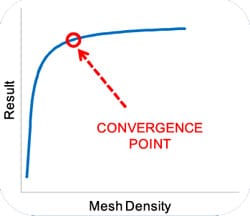
Results
Lateral Resolution of Imported Data
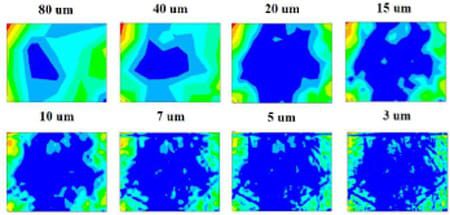
Fig. 2. – Contact Pressure 4L Sample
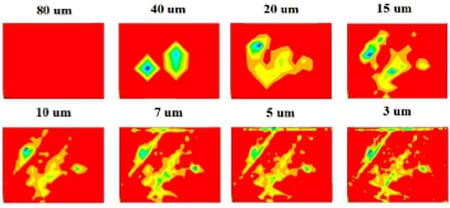
Fig. 3. – Contact Gap 4L Sample
- Looking for the effect of surface resolution on results
- Use hard plastic (soft material) PEEK for material properties

Fig. 4. – 3 surface samples, Average roughness: 0.05 um, 0.1 um, 0.2 um,
PV roughness : 3.07 um, 4.36 um, 2.8 um, Measured resolution: 2.24 um, 0.84 um, 1.14 um,
Imported resolution from 80 um to 3 um
- All three plots are tending towards convergence but none can be said to have reached it
- None of the plots use the full resolution
- None of the plots have more than one element per asperity (mesh coupled to resolution)
Mesh Density of Imported Data
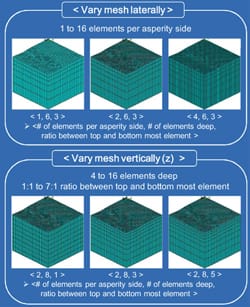
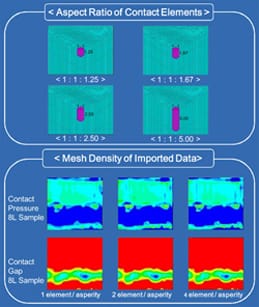
Fig. 5 – Vary mesh vertically and laterally, aspect ration of contact
elements, and mesh density of imported data..
- Use smaller data set (20 x 20) with full resolution
- Decouple mesh from resolution
- Very load
- Material aluminum 6061-T6
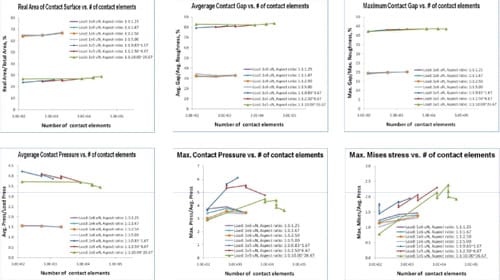
- High aspect ratios in vertical elements could be giving funny answers.
- Contact is binary: the whole element must be in or out of contact. As element size decreases, contact pressure will go up.
- Linear elastic assumption may not apply. Need to compare to elastic-plastic models to verify.
- Max Contact Pressure / Max Equivalent Stress may be hyper-sensitive parameters that are ill-suited to convergence analysis
Conclusions
Preliminary Conclusions
- Minimum resolution needed to accurately represent a surface although the relationship between that resolution and the nature of the surface is not known
- No benefit to having more than one element per asperity in applications which are dependent on real area of contact or average/maximum contact gap
- Maximum contact pressure and equivalent stress are strongly dependent on the mesh and require additional consideration
Future Work
- This presentation contains some of the early results of this work
- A much larger parameterized study has been developed to systematically eliminate variables and characterize the method. This will be the focus on our short term future work.
- Once demonstrated and accepted, this work should revolutionize and revitalize the field of tribology and have a major impact in mechanical, chemical, and medical fields
REFERENCES
- Archard, J. F. “Elastic Deformation and the Laws of Friction.” Proceedings of the Royal Society of London. Series A, Mathematical and Physical Sciences, Vol. 243, No. 1233. (Dec. 24, 1957), pp. 190-205.
- Greenwood, J. A. and Williamson, J. P. B., “Contact of Nominally Flat Surfaces” Proceedings of the Royal Society of London. Series A, Mathematical and Physical Sciences (1934-1990) Issue Volume 295, Number 1442 / December 06, 1966
- Thompson, M.K. “A Multi-Scale Iterative Approach for Finite Element Modeling of Thermal Contact Resistance” Thesis (Ph.D.)–Massachusetts Institute of Technology, Dept. of Mechanical Engineering, 2007.


